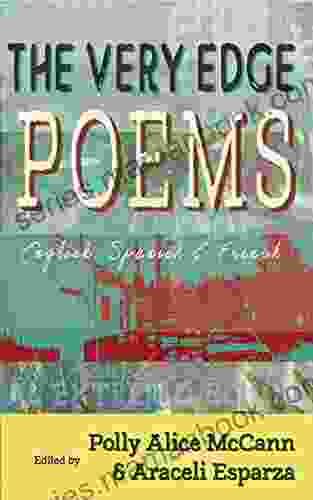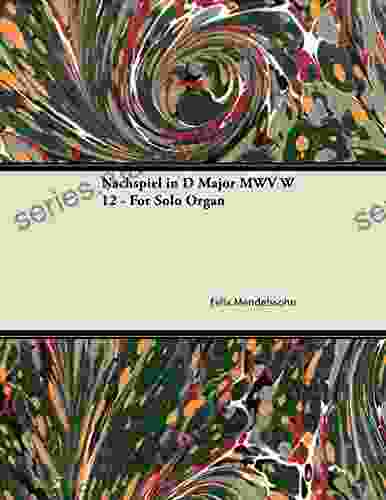Nachspiel in Major MWV 12 for Solo Organ: An In-Depth Exploration

The Nachspiel in Major MWV 12 for Solo Organ by Felix Mendelssohn is a captivating and intricate piece that showcases the composer's mastery of organ music. Composed in 1845 during the Romantic Era, this work has become a beloved staple in the organ repertoire, renowned for its rich harmonies, expressive melodies, and complex structure.
5 out of 5
| Language | : | English |
| File size | : | 1844 KB |
| Text-to-Speech | : | Enabled |
| Enhanced typesetting | : | Enabled |
| Print length | : | 14 pages |
| Screen Reader | : | Supported |
In this article, we will embark on an in-depth exploration of the Nachspiel in Major MWV 12. We will delve into its historical context, analyze its musical structure, and uncover the intricate techniques that Mendelssohn employed to create this remarkable composition.
Historical Context
Felix Mendelssohn was one of the most prominent composers of the Romantic Era, known for his lyrical melodies, vivid harmonies, and innovative use of form. His Nachspiel in Major MWV 12 was composed during a time when the organ was undergoing a significant revival in popularity. Composers such as Mendelssohn were experimenting with new ways to exploit the organ's unique capabilities, pushing the boundaries of the instrument's musical expression.
The Nachspiel was originally intended to be the concluding movement of Mendelssohn's larger work for organ, the Sonata in D Minor MWV 11. However, the Nachspiel was later published as a separate piece, quickly gaining recognition as a standalone masterpiece.
Musical Structure
The Nachspiel in Major MWV 12 is a ternary form (ABA) composition, featuring a contrasting middle section (B) that provides a striking contrast to the initial and final sections (A).
A Section
The A section opens with a majestic and expansive melody played on the full organ. The melody is based on a simple ascending scale, but Mendelssohn's use of chromaticism and suspensions creates a sense of harmonic richness and sophistication.
The A section develops thematically through a series of variations on the opening melody. Mendelssohn introduces new rhythmic patterns, embellishments, and countermelodies, creating a sense of forward motion and continuous interest.
B Section
The B section provides a striking contrast to the A section, featuring a more subdued and reflective character. The melody is played on a softer registration, and the harmony is more sparse and ethereal.
The B section also introduces a new melodic motif, which provides a contrasting element to the opening melody. This motif is developed through imitation and variation, creating a sense of dialogue between the different voices of the organ.
A Section (reprise)
The final A section is a reprise of the opening material, but with some significant modifications. Mendelssohn introduces new harmonic twists and turns, creating a sense of increased intensity and drama.
The Nachspiel concludes with a grand and triumphant coda, which brings the piece to a satisfying close.
Harmonic Development
Mendelssohn's use of harmony in the Nachspiel in Major MWV 12 is nothing short of masterful. The composer employs a wide range of harmonic techniques to create a sense of richness, sophistication, and emotional depth.
One of the most striking aspects of the Nachspiel's harmony is its use of chromaticism. Mendelssohn frequently introduces chromatic notes into the harmony, creating a sense of tension and instability. However, he always resolves these chromatic notes in a satisfying way, creating a sense of balance and order.
Mendelssohn also makes extensive use of suspensions in the Nachspiel. Suspensions are dissonant chords that are delayed in their resolution. This technique creates a sense of tension and anticipation, which is essential to the Nachspiel's emotional impact.
Thematic Development
Thematic development is another important aspect of the Nachspiel in Major MWV 12. Mendelssohn uses a variety of techniques to develop his themes throughout the piece, creating a sense of unity and coherence.
One of the most common techniques that Mendelssohn uses is variation. He takes a simple melody and transforms it through a series of variations, introducing new rhythmic patterns, embellishments, and countermelodies. This technique helps to create a sense of forward motion and continuous interest.
Mendelssohn also uses imitation to develop his themes. Imitation occurs when a melody is repeated at different pitches or in different voices. This technique creates a sense of dialogue between the different voices of the organ, adding to the richness and complexity of the musical texture.
Performance Considerations
The Nachspiel in Major MWV 12 is a challenging piece to perform, requiring a high level of technical skill and musical sensitivity. The organist must be able to navigate the complex harmonic progressions, handle the rapid passagework, and bring out the expressive melodies.
The organist must also make careful decisions regarding registration. The Nachspiel is scored for a two-manual organ, and the organist must choose which stops to use to create the desired effect. The choice of registration can significantly impact the piece's overall mood and character.
Finally, the organist must pay close attention to the piece's dynamic markings. Mendelssohn uses a wide range of dynamics in the Nachspiel, from soft and ethereal passages to loud and triumphant sections. The organist must be able to control the organ's volume effectively to bring out the full range of the piece's emotional expression.
The Nachspiel in Major MWV 12 for Solo Organ by Felix Mendelssohn is a masterpiece of organ music. Its rich harmonies, expressive melodies, and intricate structure make it a challenging but rewarding piece to perform and listen to.
The Nachspiel is a testament to Mendelssohn's genius as a composer. His ability to combine technical mastery with emotional depth has created a piece that continues to inspire and move audiences today.
If you have the opportunity to hear the Nachspiel in Major MWV 12 performed live, be sure to take it. It is a truly unforgettable experience.
Additional Resources
- YouTube: Felix Mendelssohn - Nachspiel in Major MWV 12
- IMSLP: Nachspiel in C major, MWV 12 (Mendelssohn, Felix)
5 out of 5
| Language | : | English |
| File size | : | 1844 KB |
| Text-to-Speech | : | Enabled |
| Enhanced typesetting | : | Enabled |
| Print length | : | 14 pages |
| Screen Reader | : | Supported |
Do you want to contribute by writing guest posts on this blog?
Please contact us and send us a resume of previous articles that you have written.
 Top Book
Top Book Novel
Novel Fiction
Fiction Nonfiction
Nonfiction Literature
Literature Paperback
Paperback Hardcover
Hardcover E-book
E-book Audiobook
Audiobook Bestseller
Bestseller Classic
Classic Mystery
Mystery Thriller
Thriller Romance
Romance Fantasy
Fantasy Science Fiction
Science Fiction Biography
Biography Memoir
Memoir Autobiography
Autobiography Poetry
Poetry Drama
Drama Historical Fiction
Historical Fiction Self-help
Self-help Young Adult
Young Adult Childrens Books
Childrens Books Graphic Novel
Graphic Novel Anthology
Anthology Series
Series Encyclopedia
Encyclopedia Reference
Reference Guidebook
Guidebook Textbook
Textbook Workbook
Workbook Journal
Journal Diary
Diary Manuscript
Manuscript Folio
Folio Pulp Fiction
Pulp Fiction Short Stories
Short Stories Fairy Tales
Fairy Tales Fables
Fables Mythology
Mythology Philosophy
Philosophy Religion
Religion Spirituality
Spirituality Essays
Essays Critique
Critique Commentary
Commentary Glossary
Glossary Bibliography
Bibliography Index
Index Table of Contents
Table of Contents Preface
Preface Introduction
Introduction Foreword
Foreword Afterword
Afterword Appendices
Appendices Annotations
Annotations Footnotes
Footnotes Epilogue
Epilogue Prologue
Prologue Antonio Garcia Martinez
Antonio Garcia Martinez Ryan Carter
Ryan Carter Joe Abercrombie
Joe Abercrombie Janet Evans
Janet Evans Andre Gonzalez
Andre Gonzalez Soveressence
Soveressence Daniel R Solin
Daniel R Solin Holly Sheidenberger
Holly Sheidenberger Cecil Castellucci
Cecil Castellucci Telma Rocha
Telma Rocha Dean Koontz
Dean Koontz Stephanie Oakes
Stephanie Oakes Ross Leckie
Ross Leckie Sally Hull
Sally Hull Lesley Eames
Lesley Eames Jeffery Deal
Jeffery Deal Anusree Roy
Anusree Roy Todd Hosea
Todd Hosea Jacqueline Klosek
Jacqueline Klosek Anthony Paul
Anthony Paul
Light bulbAdvertise smarter! Our strategic ad space ensures maximum exposure. Reserve your spot today!

 Guillermo BlairMy Lady Beloved Lael St James: A Timeless Tale of Love, Loss, and Redemption
Guillermo BlairMy Lady Beloved Lael St James: A Timeless Tale of Love, Loss, and Redemption
 Zachary CoxThe Injustice of Infertility: A Journey of Heartbreak, Hope, and the Search...
Zachary CoxThe Injustice of Infertility: A Journey of Heartbreak, Hope, and the Search... Avery SimmonsFollow ·19.1k
Avery SimmonsFollow ·19.1k Desmond FosterFollow ·8.5k
Desmond FosterFollow ·8.5k Leo MitchellFollow ·12.9k
Leo MitchellFollow ·12.9k Clinton ReedFollow ·18.2k
Clinton ReedFollow ·18.2k Owen SimmonsFollow ·16.5k
Owen SimmonsFollow ·16.5k Jerry HayesFollow ·12.2k
Jerry HayesFollow ·12.2k Greg CoxFollow ·7.4k
Greg CoxFollow ·7.4k Robert ReedFollow ·8.7k
Robert ReedFollow ·8.7k

 David Mitchell
David MitchellMy Surly Heart: Poetic Expressions of Unrequited Love...
In the annals of...

 Jake Carter
Jake CarterBleach Vol. 50: The Six Fullbringers - A Comprehensive...
Bleach Vol. 50, titled "The Six...

 Edward Reed
Edward ReedThe Art of Simple Food II: A Masterclass in Culinary...
In an era of culinary excess, where meals...

 Jarrett Blair
Jarrett BlairThe Easy Ingredient Ketogenic Diet Cookbook: Your Gateway...
The ketogenic diet,...

 Larry Reed
Larry ReedThe Very Edge Poems Polly Alice Mccann: A Poetic...
An to 'The Very...

 Sidney Cox
Sidney CoxThe Keys of Death and Hades: Unlocking the Epic of...
In the realm of mythology...
5 out of 5
| Language | : | English |
| File size | : | 1844 KB |
| Text-to-Speech | : | Enabled |
| Enhanced typesetting | : | Enabled |
| Print length | : | 14 pages |
| Screen Reader | : | Supported |








